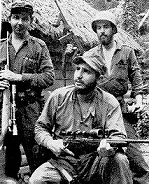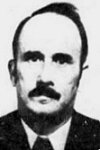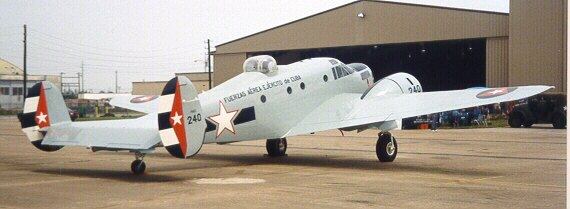

The Rebel Air Force, the Guerrilla AviationRuben Urribarres |
![]() First airplane to the guerrilla
First airplane to the guerrilla
 February 23, 1958 Fidel Castro commission its brother, the Captain Raúl Castro,
to choose 50 men of the troop and to go to the Sierra Cristal to open the Second
Front "Frank Pais". March 1 Raúl went with 67 men to their zone of operations,
arriving March 11 with 77 men, therefore various men united them.
February 23, 1958 Fidel Castro commission its brother, the Captain Raúl Castro,
to choose 50 men of the troop and to go to the Sierra Cristal to open the Second
Front "Frank Pais". March 1 Raúl went with 67 men to their zone of operations,
arriving March 11 with 77 men, therefore various men united them.
The troop needed constant provision of munitions and weapons, many of which were bought in other countries. The control of the sea by the Cuban Navy and the urgency, do that the best way of transportation be the air one.
The first airplane
was expected that landed in Moa, and the rebels of Raúl took its airport
March 31, but for lack of coordination, they retire, therefore the airplane arrived
at the zone of Fidel March 30.
 Fidel, Raul Castro and Camilo Cienfuegos
Fidel, Raul Castro and Camilo Cienfuegos
That was a Curtiss C-46 Commando number TI-1019C of Costa Rica, rented by $2,000 in Miami, United States, to a gentleman surnamed Guerra.
The C-46 transported weapons delivered by the old Leader of the Army
of Costa Rica, with the support of the president José Figueres, that asked
that the operation was discrete to not have problems with Batista. The arms were
38 rifles Mauser, 10 Beretta, several machine guns M3, two of Cal.50, 10 machine
guns Rainser, and munition.The pilot of the airplane was Pedro
Luis Díaz Lanz, future leader of the FAR after the triumph.
The airplane was damaged during the landing in Cienaguilla. The C-46, after dischargeed,
was set on fire and abandoned, to avoid that to be identified. But the Army arrived
at the place days later and identified the airplane and its origins.
 | Twin engined Curtiss C-46 Commando like the rebels |
![]() Creation of the FAR
Creation of the FAR
| The first intent of receiving an airplane was fruitless, but gives impulse to the idea of creating an own aviation, that to satisfy the continuous material needs of the guerrilla, and supported it in the battles. Orestes del Río Herrera, a rebel pilot with 500 hours of amateurs flying, worked in the matter of the fruitful reception of the C-46, was enthusiast of the idea. April 12, 1958 the Leader of the Second Front Raúl Castro, after analyzing the matter with del Río, signs the order of the creation of the Rebel Air Force (FAR), and to Orestes del Río as Leader of the new corp, ascending it to.First Lieutenant. Orestes del Río begins to organize the FAR, to gather personnel with aviation experience and to gather the air resources that had the rebels. The FAR arranged with one Piper PA-20 Pacer (delivered by Ozías Suárez), two Piper PA-12 Vagabond (delivered by Erasmo Matos and Angel Pérez), one Cessna-120. |
 Captain
Orestes del Río, first FAR´s Chieff Captain
Orestes del Río, first FAR´s Chieff |
November 30, 1958 Raúl appoints Chieff of Supply of the FAR to Ramón Castro, older brother of Raúl and Fidel, that shows the importance given to the aviation.
![]() The FAEC against the FAR
The FAEC against the FAR
An runway is
prepared in the farm "La Esmeralda", by Sagua de Tánamo, to receive for
the first airplane, a Cessna-195 bought June 19, 1958 by del Río in Miami
by $5,500. But June 20 in the afternoon 2 F-47 Thunderbolt discover the
runway. To the dawn of the following day, the rebels expect to the Cessna, but
the airplane that appears was a C-47 of the FAEC (N° 210) in recognition,
and immediately a F-47 (N° 456) overfly the the field, diving and throwing
2 bombs of 500 pounds. Then arrive a B-26 (N° 903), piloted by Roberto
Pérez Montiel (graduate in 1955), that throws 6 bombs of 100 pounds, both
aircrafts shoot more than 1,000 munition during 45 minutes.
 |
| |
.At 10 o'clock of the morning the FAEC airplanes arrive again, with the F-47 N° 464, the B-26 N° 913 and 931, and the Beaver N° 18, they bombing using napalm the infrastructures. Raúl Castro themselves coming to the place, and the Beaver shoot their jeep, that was hit. The runway remained damaged. The rebel Cessna-195 take off at night from Miami, but the motor stopped it and was crashed by San Germán. The crews Orestes del Río and Guillermo Verdaguer, left unharmed. June 28 Raúl ascends del Río to Captain. August 30 a Beechcraft D-18 with weapons is sent to the Che Guevara and lands at 20.25 o'clock hours at night by Cayo Espino.
The
Army detects it, and calls to the FAEC, her airplanes appear to the 25 minutes,
bombing and leaving useless the rebels airplane. Che
Guevara relates it: "We Were going to begin the march in trucks, August
30, 1958,  when
a fortuitous accident interrupted our plans: that night arrived a small truck
with the uniforms and the necessary gasoline for the vehicles that already were
prepared when also arrived for air way a weapons load to a nearby to the Road
airport. The airplane was located at the moment of landing, in spite of being
during the night, and the airport systematically was bombing since the twenty
until the five of the morning, then we burn the airplane to avoid that he fall
in enemy hands or to avoid the diurnal bombing, with more worse results.
The enemy troops advanced to the airport; they intercepted the small truck with
the gasoline, leaving us on foot. That we begin the march on August 31,
without trucks neither horses, expecting to find them after crossing the highway
of Manzanillo to Bayamo"
when
a fortuitous accident interrupted our plans: that night arrived a small truck
with the uniforms and the necessary gasoline for the vehicles that already were
prepared when also arrived for air way a weapons load to a nearby to the Road
airport. The airplane was located at the moment of landing, in spite of being
during the night, and the airport systematically was bombing since the twenty
until the five of the morning, then we burn the airplane to avoid that he fall
in enemy hands or to avoid the diurnal bombing, with more worse results.
The enemy troops advanced to the airport; they intercepted the small truck with
the gasoline, leaving us on foot. That we begin the march on August 31,
without trucks neither horses, expecting to find them after crossing the highway
of Manzanillo to Bayamo"
![]() Helicopter and bombs of the rebels
Helicopter and bombs of the rebels
This it was a project begined by the rebel Lieutenant Evans Rosales, second leader of the FA and Chief of the shop. He used parts of the fuselage and motor of a retired Piper PA-12. On November 14 Evans achieves to extract of the two DC-3 destroyed in Mayarí Arriba parts and other mechanisms for its project. However, the technical and material lack impedes that be carry out this project. Likewise the factory of Evans begin the construction of 100 pounds bombs for the FAR, and of grenades and mines for the rebel troop. The main source of materials were the non exploited bombs of the FAEC and they should be utilized against their old owners.
 | Rebels with its own production aviation bombs. Aside from these bombs, they manufactured rifle grenades, mines and other appliances |
![]() Military Airplanes of the FAR
Military Airplanes of the FAR
The first real military airplane able in rebels hands coincidentally was captured for the FAR November 10, when landing in rebel territory a Vought Sikorsky OS2U-3 Kingfisher FAN N° 50 of the naval aviation, that had problems with the motor and was piloted by the Lieutenant Antonio E. Bascaró Sánchez. In the official report of the FAR told that the Kingfisher was "intercepted" and captured, to do to the Army believe that the FAR has fighters.
 |
Beech D-17S like the FAR. The Kingfisher flying with her motor |
 |
December 4 at 17.45 o'clock arrives a North
American T-28 Trojan to Mayarí Arriba directly from Miami, piloted
by Jorge Triana. The airplane arrived in perfect conditions and with Jorge came
a doctor. The following military airplanes are the two North
American F-51 Mustang described in the next chapter, and that arrived
at the war´s end. As curiosity, is able to say that the motor of the Kingfisher
really had serious problems and could not be repaired with the scarce rebel resources.
Therefore the airplane was repaired adapting him the motor of the Beech D-17S
(that crashed the September 29 when landing), this work was made in campaign conditions
and with total success.
![]() Related articles
The Trasatlantic Flight of Menendez Pelaez
1913. Audacious Flight of Rosillo and Parlá
1933-1938, Cuban Military Aviation. The 1933 Revolution and her consequences.
Related articles
The Trasatlantic Flight of Menendez Pelaez
1913. Audacious Flight of Rosillo and Parlá
1933-1938, Cuban Military Aviation. The 1933 Revolution and her consequences.
![]() External Links
Cuban Military Forum
External Links
Cuban Military Forum
|
|
|
|
|||
